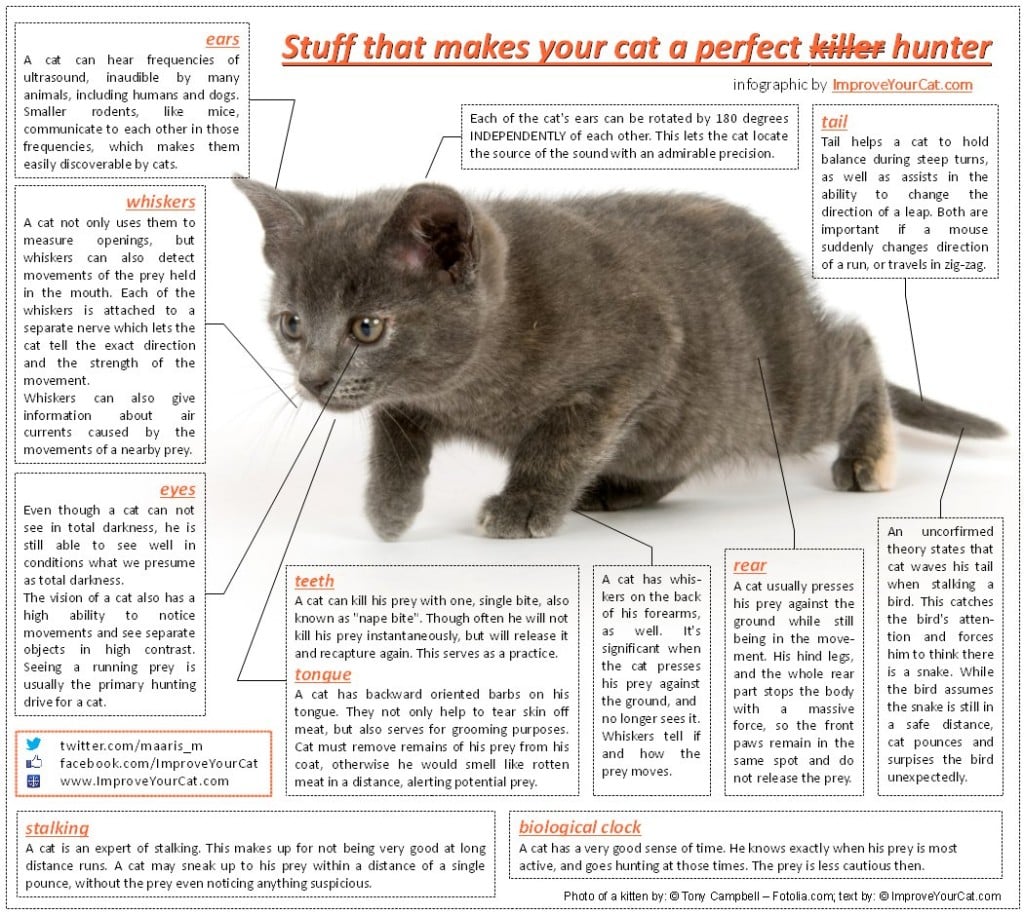Research shows domestic cats are extremely good hunters with an average of every third pounce resulting in a catch. Only a few other animals, mostly large cats, can beat it.
Is it a coincidence? Not even close, here are the reasons why cats are one of the most successful hunters ever walked on the Earth.
Click the image to see it larger, or read below for a textual version of the infographic.
1. ears
A cat can hear frequencies of ultrasound, inaudible by many animals, including humans and dogs. Smaller rodents, like mice, communicate with each other in those frequencies, which makes them easily discoverable by cats.
Each of the cat’s ears can be rotated by 180 degrees INDEPENDENTLY of each other. This lets the cat locate the source of the sound with admirable precision.
2. whiskers
A cat not only uses them to measure openings, but whiskers can also detect movements of the prey held in the mouth. Each of the whiskers is attached to a separate nerve which lets the cat tell the exact direction and the strength of the movement.
Whiskers can also give information about air currents caused by the movements of nearby prey.
A cat has whiskers on the back of his forearms, as well. It’s significant when the cat presses his prey against the ground, and no longer sees it. Whiskers tell if and how the prey moves.
3. eyes
Even though a cat can not see in total darkness, he is still able to see well in conditions what we presume as total darkness.
The vision of a cat also has a high ability to notice movements and see separate objects in high contrast. Seeing a running prey is usually the primary hunting drive for a cat.
4. teeth
A cat can kill his prey with one, single bite, also known as “nape bite”. Though often he will not kill his prey instantaneously but will release it and recapture again. This serves as a practice.
5. tongue
A cat has backward oriented barbs on his tongue. They not only help to tear the skin off meat but also serves for grooming purposes. A cat must remove remains of his prey from his coat, otherwise, he would smell like rotten meat in a distance, alerting potential prey.
6. rear
A cat usually presses his prey against the ground while still being in the movement. His hind legs and the whole rear part stops the body with a massive force, so the front paws remain in the same spot and do not release the prey.
7. tail
The tail helps a cat to hold balance during steep turns, as well as assists in the ability to change the direction of a leap. Both are important if a mouse suddenly changes the direction of a run, or travels in zig-zag.
6. stalking
A cat is an expert in stalking. This makes up for not being very good at long-distance runs. A cat may sneak up to his prey within a distance of a single pounce, without the prey even noticing anything suspicious.
7. biological clock
A cat has a very good sense of time. He knows exactly when his prey is most active and goes hunting at those times. The prey is less cautious then.

